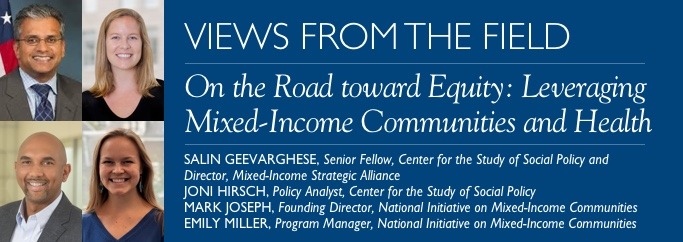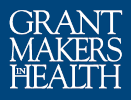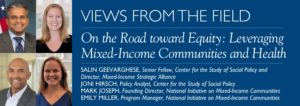
Joni Hirsch, Policy Analyst, Center for the Study of Social Policy
Mark Joseph, Founding Director, National Initiative on Mixed-Income Communities
Emily Miller, Program Manager, National Initiative on Mixed-Income Communities
The negative effects on health of housing instability, growing income inequality, concentrated poverty, and racial segregation are undeniable. In fact, the health inequities resulting from these challenges are getting worse, exacerbated by market forces, policy gridlock, and increased political polarization. At the same time, these challenges have also galvanized various cross-sector leaders concerned about housing and health. Health funders have been among those stakeholders who are exploring the synergies between health and housing, only to realize that each policy domain presents a complicated world to navigate. Amidst that complexity and often through the lens of revitalizing neighborhoods in their targeted geographies, funders are recognizing that mixed-income communities have the power and potential to be a solution for a diversifying and polarizing America, offering opportunities to bridge the social divide, change mental models about the “other,” and demonstrate the economic and social vitality of equitable, inclusive, mixed-income communities.
In 2017, the Mixed-Income Strategic Alliance—a partnership of the Center for the Study of Social Policy (CSSP) based in Washington, D.C.; the National Initiative on Mixed-Income Communities (NIMC) based in Cleveland, OH; and, Urban Strategies, Inc. (USI) based in St. Louis, MO—started a learning exploration in partnership with, and supported by, the Robert Wood Johnson Foundation (RWJF) to unpack the intersection of housing and health. The goal was to build knowledge and advance the mixed-income field toward greater inclusion and equity.
Prior to our inquiry, we knew from existing research that:
- Low-income communities benefit from the physical revitalization of a mixed-income transformation, but experience increased social exclusion.
- Increased neighborhood diversity leads to increased social isolation and lower social cohesion.
- Higher social isolation leads to worse health outcomes.
Faced with this discouraging evidence, RWJF and the Mixed-Income Strategic Alliance wanted to understand whether and how mixed-income community interventions could be a positive transformational lever for creating equitable, inclusive, and healthy places to live.
We started our work by engaging in an assessment process to identify and spotlight mixed-income communities that had an intentional, strategic focus on health. We developed site profiles of mixed-income community interventions in five cities: Cincinnati, Denver, Richmond, San Francisco, and Seattle. Research highlights include the following:
- While only some sites used an explicit social determinants framework in their planning, all of them incorporated strategies that went beyond a narrow range of health-related services and demonstrated an expansive view of health and wellness (e.g., community engagement activities, social networking strategies, community health, access to healthy food).
- While all of the site strategies included programming designed to promote better health outcomes among residents, there was surprisingly little consideration across sites about how the mixed-income nature of the development itself could be a factor in promoting better health and wellness.
- The stressors experienced by families in poverty can be exacerbated by a mixed-income transformation, at least in the short term. Thus, mixed-income interventions should anticipate and address both existing and new health and mental health issues that will emerge directly from the redevelopment process, while also attending to current and past trauma.
- Targeted approaches are needed for scale and systems change, requiring broader structural changes that would make the existing systems work more effectively for low-income populations of color in marginalized neighborhoods.
- While structural racism and racial segregation were acknowledged as fundamental drivers of the health disparities that existed in these communities before the revitalization efforts, most mixed-income transformations lacked explicit strategies to promote racial equity.
- An early and consistent commitment to including residents in the design and implementation of initiatives was essential.
Typical of any exploration, there were unanticipated discoveries along the way that required further attention. For instance, as we conducted additional interviews and conversations, our appreciation of the importance of social dynamics within mixed-income communities grew. Within mixed-income communities, relationships across race and class are often assumed because of physical design that maximizes proximity and density. However, while living near each other might facilitate relationships across lines of difference, research confirms that this does not naturally occur. In fact, there can be more exclusion than inclusion, more stigmatization than belonging, and more isolation than cohesion. This recognition has profound consequences for the health of residents in these communities, revealing positive and negative outcome pathways that can emerge.
Our work also revealed that inclusion or exclusion within mixed-income communities can be usefully understood and addressed at three different levels: individual, social, and structural. At the individual level, self-perception and feelings of efficacy, agency, and identity are at play, with incentives, rewards, and leadership development being among the strategies to promote inclusion. At the social level, peer relationships, social capital, and social networks are key, and structures for engagement, personal relationship, and celebration can serve as drivers of inclusion. At the structural level, inclusion, influence, and power dynamics manifest in governance, voice, and participation processes.
Four promising practices that we identified and documented—Trauma Informed Community Building, Kindred’s in-school racial bridging, Trusted Space Partners’ community network-building, and Regent Park in Toronto’s governance structure—illustrate that strategies can be tailored to these levels to achieve specific outcomes. These models show that creating the conditions for inclusive social dynamics in mixed-income communities is within reach.
Health funders are in an excellent position to incorporate the lessons from this research into their partnership and investment practice. Recommendations for funders include:
- Have a more expansive view of health, accounting for direct and indirect interventions and going beyond service provision.
- Be explicit and intentional in investment strategies about leveraging the mixed-income aspects of a development as a resource for change, including the diversity and demography of the neighborhood.
- Insist on centering racial equity and addressing disparities in the work of mixed-income communities.
- Commit to and resource resident inclusion in initiative design, governance, and decision-making.
- Remember that the social dynamics of communities are critical for health and that individual, social and structural dimensions are all in play.
If mixed-income communities are to achieve their potential as a promising strategy for equity, inclusion, opportunity, and health, it will be because funders, policymakers, practitioners, researchers, residents, and all concerned stakeholders were intentional about results and the required capacity and resources. Change will not happen by chance.
Find all our reports here.

